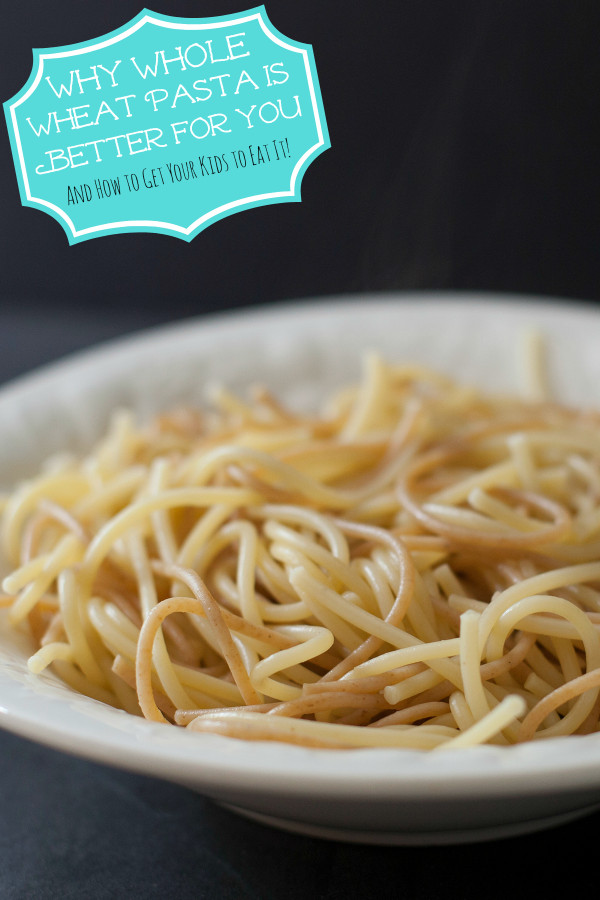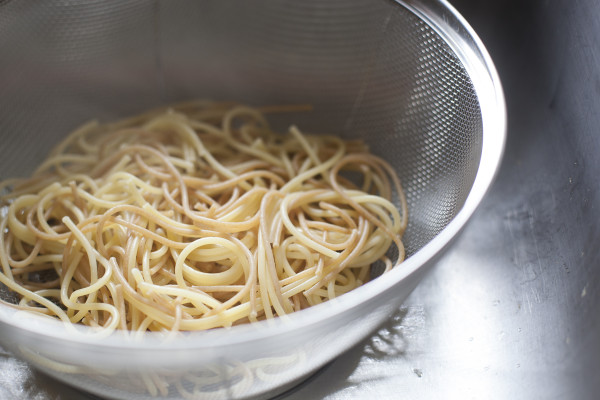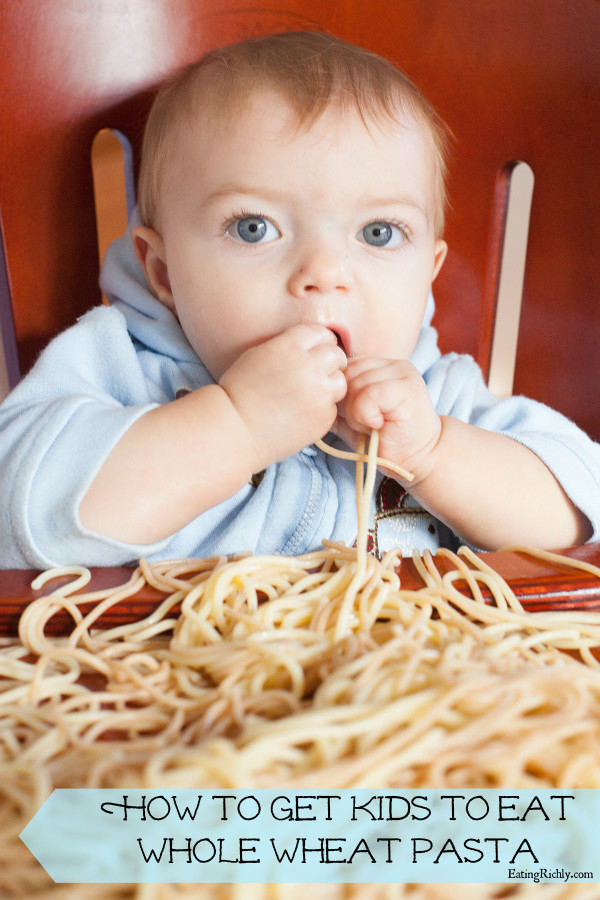First of all, if you have a gluten allergy or intolerance, you may just want to skedaddle right out of here and check out some of our gluten free recipes. This post is mostly about the gluten happy, carbo loaded, wonderful world of wheat pasta. Gluten free pasta is a whole different set of tips and rules, and a gluten free blogger is much better equipped to talk about the best gluten free pastas. But there is some information here on a few whole grain and gluten free pastas r(ight below the Whole Grain vs Whole Wheat heading), and you can also scroll down toward the bottom to read about some Pasta Substitutes.
This is a pretty in depth article, so I’ve tried to break it down into a few sections to help you navigate it easily. Ready? Here we go!
Whole Grain vs Whole Wheat
Isn’t whole wheat a whole grain? Or is a whole grain whole wheat? Or is it all just marketing mumbo jumbo that actually means nothing at all? The world of food labeling is a tricky, and sometimes dark and scary, place. It’s even harder to understand when there is so much misinformation out there. A Google search for whole grain vs whole wheat can bring up several sites in the top results that have completely different information. How do you know what’s true?
I decided to go right to the source, the Whole Grains Council. 
Recognize those symbols? Those are the whole grain stamps that you see on various packages of food all over your grocery store. Every item that bears that stamp has been reviewed by the Whole Grains Council, which is a non-profit dedicated to helping people eat healthier. Companies with qualifying products pay a fee to have the stamp of whole grain approval on their packaging. This fee helps to cover reviewing costs, and the free education work the Whole Grains Council engages in. Cynthia, their Director of Food and Nutrition Strategies, rapidly responded to my email asking for clarification on the whole grains vs whole wheat issue.
“Whole wheat is one type of whole grain, just as carrots are one type of vegetables. Although all carrots are vegetables, not all vegetables are carrots, right? So, similarly, all whole wheat (in the U.S.) is whole grain — but not all whole grains are whole wheat.”
Here’s where it gets confusing. In some parts of the world (like lovely neighboring Canada), labeling laws allow something to be called whole wheat if it contains 95% of the original wheat kernel. Not so in the United States. This is the key point, so pay attention.
“By law in the U.S., something labeled “whole wheat” must contain 100% of the original three edible parts of the wheat kernel (the bran, the germ and the endosperm) in their original proportions. This makes whole wheat a whole grain.”
Got that? The answer is yes, whole wheat is whole grain. You can read more about various regulations and guidelines in regards to whole grains on their Government Guidance page.
Now whole wheat is not the only whole grain pasta. You can find 100% whole wheat pasta, or pasta that is partly whole wheat (a mix of whole wheat and refined wheat, like 2% milk is a mix of whole milk and skim milk). But you can also get brown rice pasta, quinoa pasta, and quinoa and corn pasta, all of which are whole grains.
For the sake of simplicity, we’re going to focus on whole wheat today.
Is Wheat Pasta Actually Bad For You?
Ah the great debate. Is pasta good for you? Is pasta evil? Does pasta make people fat?
There are so many diets, articles, and blogs out there that are anti-grain, anti-carb, and anti-gluten. Let me be clear. Some people have serious medical conditions, allergies, or an intolerance that make living gluten or grain free a necessity. A lot of people have seen their quality of life changed dramatically by cutting out certain foods, including wheat and other grains. If you are experiencing health issues, it might be worth talking with your doctor about dietary adjustments.
But please consult a doctor or nutritionist if you are going to give up grains completely. Get professional guidance on how to get the recommended fiber, vitamins and other nutrients on a grain free diet.
I have scoured the internet and talked to nutritionists and doctors in trying to determine any benefits to giving up grains completely. While I’ve found lots of studies on the benefits of whole grains, it’s been difficult to find any on grain free diets. There is blog post after blog post on why grains are bad for you, but I’ve yet to find one with independent studies to back them up. Don’t get me wrong, I certainly believe that grain free is a dietary need for some people, but I have not found evidence that grains are bad for humans in general.
Whole Wheat Pasta Nutrition
So what is the actual nutrition in whole wheat pasta? How many calories are in whole wheat pasta? Why is it better for me than the white stuff?
Now that we understand the definitions of whole grain and whole wheat, let’s look at why whole wheat pasta is healthier for you than refined or white pasta. First of all, let’s once again figure out some terminology.
Refined flour is flour that has had the nutrient-rich bran and germ removed during milling. All that’s left is the endosperm, which still has some nutrients, but a lot is missing. This process gives it a longer shelf life. Refined flour is also sometimes called white flour, so products made with it are often called white pasta, white bread, etc.
But, there is also whole white wheat flour, which is made from a specific type of wheat (called “white wheat”) that has a much lighter color and milder flavor than normal whole wheat (which is called “red wheat” — even though it isn’t very red). White wheat is kind of like albino wheat! It is whole wheat, because it contains all three parts of the wheat kernel. A lot of my recipes call for whole white wheat flour, and if you see it listed in a product, you can know that it still has great nutritional value, even with the term “white”.
Let’s get back to the nutrition. Refined flours are missing 50-85% of a whole slew of key nutrients like fiber, B vitamins, protein, and minerals. A lot of white flour products are “fortified” with vitamins and minerals, but that doesn’t mean they have the same nutritional benefits as whole wheat. A study of wheat flour iron fortification in 78 countries revealed that most current iron fortification programs are ineffective. Also, because some things (like fiber) have been largely removed, refined flour products like pasta have higher calorie counts than their whole wheat cousin.
Here’s a nutritional chart on the percentages of various nutritional values of different refined wheat flours compared to hard red wheat. The chart is created with combined data from the USDA. You’ll notice that the majority of the nutritional values are lower. A few times they are significantly higher than 100%, that means the nutrient has been artificially added. For instance, self rising enriched all-purpose flour has 1,165 % the amount of calcium. Seems like a great thing, except that the efficiency of calcium intake actually decreases as calcium intake increases. That means it’s better to get smaller amounts of calcium throughout the day, than the super load artificially put into fortified or enriched foods. Here is a similar chart in graph form.
Studies have definitely proven the benefit of whole grains. Daily consumption of 3 portions of whole-grain foods can significantly reduce cardiovascular disease risk in middle-aged people through lowering blood pressure according to a Randomized Control Trial by the University of Aberdeen. A Harvard study found that middle aged men who ate 40 grams of whole grains per day, cut middle-age weight gain by up to 3.5 pounds.
The Whole Grains Council summarizes the benefits of whole grains most documented by repeated studies including: “stroke risk reduced 30-36%, type 2 diabetes risk reduced 21-30%, heart disease risk reduced 25-28%, and better weight maintenance.” The American Diabetes Association website says “If you are going to eat grain foods, pick the ones that are the most nutritious. Choose whole grains. Whole grains are rich in vitamins, minerals, phytochemicals and fiber.”
While several studies have shown whole grain rye has even greater health benefits than whole wheat, once again, we’re focusing on whole wheat because it is more readily available and easier to adapt to if your family is used to eating refined wheat products.
Another interesting tidbit from Cynthia with the Whole Grains Council, is that “research increasingly shows that it’s important to keep your blood sugar steady for a wide range of health reasons. Foods that send your blood sugar on a roller coaster ride — spiking and then crashing — are said to have a high Glycemic Index. Foods that supply steady, even fuel are said to have a low Glycemic Index. If you take the same wheat and make some of it into bread and some of it into pasta, the pasta will have a much lower Glycemic Index, and therefore will be a healthier choice. That’s because the pasta extrusion process rearranges the starches in a way that slows down their digestion, in a good way. A moderate serving of pasta, buried in vegetables, tomato sauce, herbs and a little lean protein makes a very healthy meal!”
How to Get Your Family to Eat Whole Wheat Pasta
I know this is the real question on many of your minds. Perhaps you’ve known for years that moving away from processed, refined, wheat ingredients is better for you, only to be shot down mercilessly when your husband and children started a hunger strike once you tried to make the switch.
The typical mistake people make when switching to whole wheat pasta, is to suddenly get rid of all refined flour pasta and use only 100% whole wheat. This is a drastic adjustment. Our tastes and food cravings develop over time, so changes need to happen over time as well.
You can start by trying a product like Barilla Whole Grain, which contains part whole wheat. I got several varieties of their pasta to review when it first came out, and didn’t really notice much of a difference in taste or texture between the whole grain or regular varieties. It’s also a very affordable option.
My favorite way to transition though, is to use part refined pasta and part whole wheat pasta, like you see in the photos. This way you are slowly adjusting your family’s tastes to the whole wheat pasta that you hope to eventually use exclusively. Start with 3/4 refined pasta and 1/4 whole wheat. After a couple weeks, go to half and half. Another couple weeks and you can switch to 1/4 refined pasta and 3/4 whole wheat. By 6-8 weeks of transition you should be able to use whole wheat pasta on its own. This is assuming that your family is the typical American family eating pasta at least three times a week. If you eat it less (like we do), it may take a little longer at each stage.
You also want to be mindful of what kinds of recipes you’re using during this transition time. A meal with a lot of sauce and other textures, such as spaghetti and meat sauce, chicken alfredo, or a baked casserole, will fare better than a pasta recipe with a very light sauce.
I know this works, because I’ve tried it with my husband. Recently, we had spaghetti made with the same white pasta noodles we used to use, and he was shocked at how much he didn’t like it. Several of my cooking class students have tried the same technique to great success.
How to Make Whole Wheat Pasta Recipes Even Healthier
If you’re concerned about calories, fat, or just general health, there are lots of ways to make pasta recipes healthy. We already talked about the benefits of whole wheat pasta, but that’s not the only path to noodle nutrition.
The obvious way to healthier pasta recipes is moderation. While whole wheat pasta is better for you, if you’re trying to lose weight or have diet related health issues, eating large quantities of whole wheat pasta every day is not going to help you. You can try substituting some vegetables for part of the pasta a recipe calls for. For instance, in an alfredo recipe, cut the amount pasta in half and substitute some steamed broccoli instead.
Another way to indulge in pasta but still eat healthy is what you eat with it. While alfredo, lasagna, and that cheesy Tex-Mex bake might taste amazing with whole wheat pasta, they are going to be FULL of fat and calories. Instead, choose a red sauce with lots of pureed vegetables, and ground turkey or lean ground beef. If you aren’t a fan of red sauce pasta, try a pasta tossed with a light sauce like goat cheese kale and spinach penne, acorn squash and sage brown butter spaghetti, or spinach and artichoke pasta.
Pasta Substitutes
Congratulations! You are now a healthy pasta expert. But what if you want to try foregoing pasta altogether? Perhaps someone in your family has diabetes, or you’re looking for an even lower calorie option. Good news my friend, there are some healthy pasta substitutes you can grow in your own backyard!
One of the most popular vegetable pasta substitutes is spaghetti squash. This winter squash can be white, yellow, or orange (orange has the most nutritional value) and looks like any other member of the squash family when raw. But once you cook it, the flesh of the squash transforms into soft and stringy noodle-like strands, making a perfect substitute for spaghetti. You can use it with a red sauce, or get creative with something like Spaghetti Squash Sesame Noodles with Edamame.
My favorite substitute for macaroni noodles is the humble cauliflower. You can be wild and crazy and use a purple cauliflower, but if you’re trying to help a picky eater get some vegetables, white cauliflower is a nearly undetectable stand in for kids. I have served my cauliflower macaroni and cheese to hundreds of kids throughout years of cooking classes, and even the pickiest of them has gobbled it down.
There are a plethora of eggplant lasagna recipes all over the internet. Thick slices of eggplant hold up well in place of sheets of pasta, and I must admit that every time I mean to make a new eggplant recipe, I end up cooking it with tomato sauce and meat because it just works so well.
Zucchini is another versatile pasta substitute. It can be used like eggplant to make lasagna, you can use a vegetable peeler to make flat ribbons of zucchini for noodles, or julienne slice them as thin or thick as you want for a spaghetti noodle substitute.
Don’t forget the humble potato. A lot of pasta sauce recipes will work well over potatoes, especially hearty ones like beef stroganoff. You can simply roast or boil the potatoes and smash them a little on the plate, no need to add butter or cream because you’ll be getting lots of flavor from the sauce. Leave the skins on for even more nutrition.
The Bottom Line
So, after sifting through all this information, what conclusions can we draw? The most obvious one: if you’re going to eat pasta (the average American eats 20 lbs of pasta a year!), whole grain pasta is the healthy choice, and switch slowly to make it an easy transition for the whole family. 



I love WW pasta. That is only what I now eat. Since I was diagnosed as being diabetic in 2008, I switched right away and cut portion sizes. It really helps keeping my blood sugar from spiking much better then the white pasta.
This is a good post! When I do eat noodles they have to be gluten free. And I know that this post isn’t about gluten free noodles. But if anyone is curious about a good gluten free noodle, then they should check out ‘pasta joy’. It is super good!